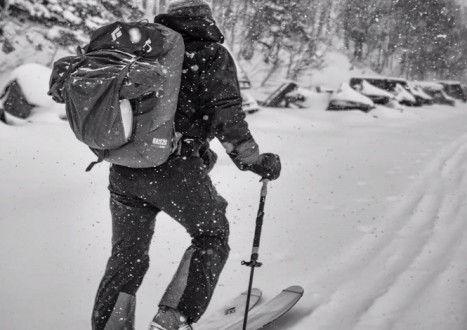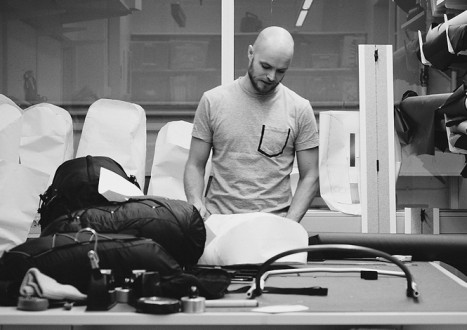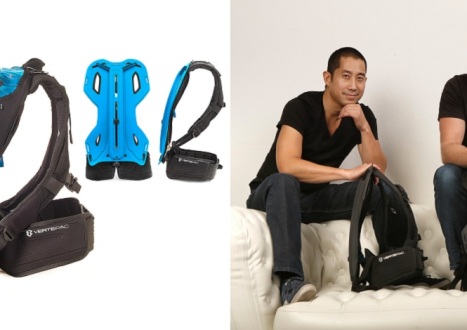
Interviews
-

Bag Collectors :: Alan Wenker
There are numerous bags in the world, but sometimes one comes along that makes an impression,... Read more
-

5 Minutes with Linjer
It’s easy to assume Linjer have been in the carry game for a long time. Just... Read more
-

Bag Collectors :: JP Guilbert
Our Bag Collectors series celebrates those individuals who take their appreciation of bags to the next... Read more
-


Design Heads :: master-piece Japan
Over two decades in the carry industry, master-piece has firmly cemented its reputation as one of... Read more
-

Bag Collectors :: Tony Held
Meet Tony Held, CEO and co-founder of Incase, and world-class bag collector…or bag user as he... Read more
-

Urban Kraft :: Paper Just Rolled into Fashion
In the carry world, standing out from the crowd isn’t easy. Urban Kraft however are all... Read more
-

5 minutes with RIOKAIRYU
There’s a lot to be said for a functional bag…but sometimes the focus is so much... Read more
-

Specialist Carry :: Cave Photographer
What lies beneath our feet might be the most unexplored expanse on Earth. The Underworld. A... Read more
-


Interview with Treesizeverse
Etsy is one huge gold mine of gorgeous (and not so gorgeous) handmade stuff. Amongst a... Read more
-

Specialist Carry :: Cinematographer
Cinematographer, Canon Master, world traveler…all apt descriptions of Abraham Joffe. But at the heart of it... Read more
-


Design Heads :: Jedd Rose (Topo Designs)
It must feel pretty great being a co-founder and Creative Director of one of the most... Read more
-

Bag Collectors :: Regan Chernish
There are people who love bags…and then there are people who REALLY love bags. Exceptional enthusiasm,... Read more
-

Miggo :: A New Way to Carry
Some might not know, but for decades, the camera carry manufacturing industry thrived in Israel. Then,... Read more
-

5 Minutes with Helinox TERG
South Korean outdoor adventure equipment brand Helinox create some of the strongest and ultralight gear on... Read more
-

5 Minutes with HoldFast & Carry Giveaway
HoldFast was founded by Matthew Swaggart through a desire to create American-made camera carry that was... Read more
-

5 Minutes With Monofold
Imagine with one fold you could change the look and functionality of your bag. Brandon Hong... Read more
-

5 Minutes with Bagagiste
For the latest in our ‘5 Minutes with’ series we’re serving up a slice of insight... Read more
-


Design Heads :: Interview with Evan Hong of Incase
Good design is often interpreted in many ways, but designer Evan Hong of Incase has relied... Read more
-


Design Heads :: Derick Noffsinger
As a senior industrial designer and company owner, with clients including Black Diamond Equipment, Thule, Gregory... Read more
-

From Rough Diamond to Polished Design :: Black Diamond JetForce Interview (Part 2)
Fresh off part 1 of our interview with Black Diamond’s Pete Gompert, Derick Noffsinger, Nick Rueff... Read more
-

From Rough Diamond to Polished Design :: Black Diamond JetForce Interview (Part 1)
If you’re hitting the slopes in avalanche territory, having an avalanche airbag backpack goes a long... Read more
-


Carry Evolution :: Boreas Aperture
Boreas Gear gave the world of pack suspension systems a wake-up shake with the introduction of... Read more
-


Pushing the Horizon | At the Helm of Côte&Ciel
Stephan Wembacher is a bit under the weather. So he says, spread over two chairs at... Read more
-

5 Minutes with SSCY
Creation through necessity is the name of the game with Brooklyn-based SSCY. The brand’s carry is... Read more
-

Carry Evolution :: YNOT Cycle Pan-Yay
Toronto-based YNOT Cycle sprung into gear when owner Tony Mammoliti couldn’t find urban cycling gear that... Read more
-


Design Heads :: Henrik Björkman (Haglöfs)
A brand that can boast a hundred years of history is doing something right. Haglöfs is... Read more
-


Looptworks :: Moving Towards A Circular Economy
Portland-based Looptworks loves nothing more than liberating the potential in excess materials through upcycling. Co-founded by... Read more
-


5 Minutes with BLC
BLC (Brownbreath Liberated Congeries) is a South Korean streetwear brand that’s been releasing some rad carry... Read more
-


5 Minutes with Forceprotector Gear
Founded in 2005 by Ed Perez, Forceprotector Gear focuses on producing A-grade military deployment gear –... Read more
-


Design Heads :: Hubert Mean & Thanh Thrinh (Crafted Goods)
Crafted Goods have been on our radar this year, no doubt about it. So we thought... Read more
-


Carry Ageing :: with Kletterwerks
When you’ve got a lifetime warranty on your gear, you’re bound to see waves of aged... Read more
-


Carry Evolution :: The Shrine
Under his consultancy, studioFAR, Fernando Robert, has designed soft goods for some of the best: Chrome Bags, Aether Apparel,... Read more
-


5 Minutes with Bleu de Chauffe
Bleu de Chauffe bags rock a blend of chic French style and practical functionality for everyday... Read more
-


Brooks :: A History of Bicycle Carry
Brooks has over a century’s worth of history behind it and has built up a solid... Read more
-


Carry Innovation :: Interview with Vertepac
“Stan went out to get a joint,” was the first thing co-founder Jeroen Janssen (right) said... Read more
-

Huayhuash Carry — Joey Schusler Interview
In the winter of 2014, Joey Schusler and two friends set out to circumnavigate one of the... Read more
-


5 Minutes with Ucon Acrobatics
Ucon Acrobatics is a Berlin-based lifestyle brand that was founded in 2001 by Jochen Smuda and... Read more
-


5 Minutes with Winter Session
Denver-based Winter Session started as a side project for Roy Katz and Tanya Fleisher to utilise their... Read more
-


American Luxury Defined :: Interview with Parabellum
As a photographer with a background in marketing and PR, John Pangilinan has made many connections... Read more
-


Interview with Kevin Murray of Velomacchi
With an already impressive resume having worked with brands such as The North Face, Black Diamond,... Read more
-


Bodypacks :: Interview with Aarn Tate
Look at a backpacker side on, and it becomes obvious that something is wrong. We humans... Read more
-


Leader Bag Co :: Baby Business
Diaper bags are a staple when it comes to EDC for new parents. The problem is... Read more
-


Design Heads :: Kema Subsomboon (booq)
booq creates a range of sleek, modern carry aimed at the creative professional. There’s a focus... Read more
-


Whillas and Gunn Interview :: The Road Less Travelled
When a large part of your time is spent having round-the-world adventures, life’s pretty good. What’s... Read more
-

Specialist Carry :: Storm Chaser
For some people an approaching storm means it’s time to head indoors and batten down the... Read more
-


Cult Bags :: The Revival of the Jensen
Rivendell Mountain Works is inextricably linked with a legend among bags – the Jensen Pack. However,... Read more
-


5 Minutes with Farrah Design
Tom Farrah formed Farrah Design as a means of creating beautiful and durable items that achieve... Read more
-


Interview with Mercy Supply :: Leather & Local
Michigan-based Mercy Supply pride themselves on creating handcrafted products using top-notch and ethically produced materials. To... Read more
-

Fernando Bonastre Interview & Roztayger.com Giveaway
To celebrate the arrival of the new Bonastre collection appearing atop her digital shelves Elizabeth Jeffer,... Read more
-

QWSTION Interview :: Brand, Beginnings and Business
QWSTION was formed by five founders who shared a passion and a problem – an appreciation... Read more





 Carry Awards
Carry Awards Insights
Insights Liking
Liking Projects
Projects Interviews
Interviews